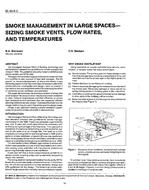This paper deals with the effects of air leakage in residential buildings and provides an overview of the influence of air leakage on the measured performance of the interior temperature and relative humidity in two very different US climate zones (IECC zone 4, Knoxville) and (IECC zone 6, Madison).
The air leakage of residential buildings depends on a number of factors like building age, volume or the climate zone, as it is a common assumption that in colder climate zones more importance is attached to airtight buildings than in warmer climates. To quantify these differences and to show the dependence of air leakage on various influences an investigation in occupied buildings has been carried out. The air tightness of a number of homes in the mixed climate of eastern Tennessee and in the cold climate of south-central Wisconsin was measured on a seasonal basis. The interior conditions were monitored for each of the homes to investigate the link to the respective air leakage of the buildings. The results show that an estimation of the air leakage of residential buildings can be made with knowledge of some simple boundary conditions. Seasonal changes do not have a significant influence on the air leakgage. This information is critical for developing reasonable boundary conditions for hygrothermal models.
Presented at Thermal Performance of Exterior Envelopes of Whole Buildings X – December 2007
Units: Dual
Citation: Thermal Performance of Exterior Envelopes of Whole Buildings X
Product Details
- Published:
- 2008
- Number of Pages:
- 10
- File Size:
- 1 file , 1.7 MB
- Product Code(s):
- D-BldgsX142


